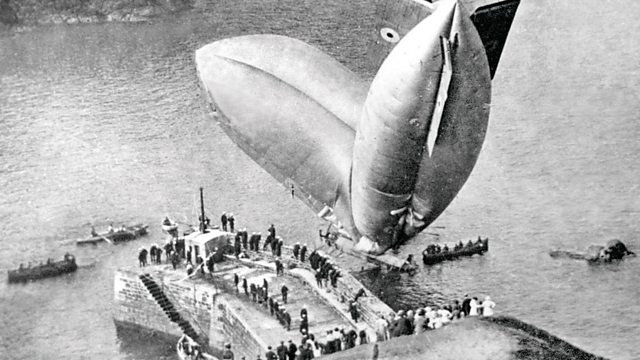RNAS Mullion, Cornwall: Patrolling the Sea
Safeguarding Britain’s war effort by protecting transport over waters
RNAS Mullion was built on one of the highest points on the Lizard peninsula at Bonython on Goonhilly Downs. The site with its two vast hangars was strategically important; protruding into the Channel, it was a launch point for anti-submarine patrols along the Channel and West towards the Isles of Scilly.
Two main types of airships were flown from RNAS Mullion including a Coastal Class known as C-class, as local historian, Pete London, explains: “The aircraft couldn't be taxied and were reliant on the ground handling crew. Teams of men would walk the airships around using rods connecting the airship with the ground. The crews faced long and exhausting missions as long as 20 hours from dawn until dusk. They were long and gruelling missions in cramped cockpits open to the cold air with no escape from the engine noise."
"Flying was regarded as something outside the ordinary man's experience", said Frederick Verry.
The memories of one of the airship pilots Frederick Verry were recorded for the archives of the Imperial War Museum in 1972. He was stationed at Mullion from 1917.
"We would keep a watch on fishing fleets of which in my particular area there were considerable numbers and one would often come across perhaps thirty or forty fishing boats, fishing, and it was a useful exercise to keep a watch over them because there were recorded cases of submarines coming up on the surface and shelling the fishing fleets."
Pete goes on to describe one astonishing incident involving Airship C-9: “The aircraft had been on patrol over the Channel Islands where despite its identity markings, British troops shot at it, perhaps mistaking the balloon for a Zeppelin.”
Leaking its hydrogen gas, the punctured airship limped back towards the Cornwall coast just reaching Mullion Cove. Seriously deflated, the gondolier in which the crew sat was trailing in the water, its damaged balloon hanging above in a peculiar arch. An archive photograph shows locals gathering on the cliffs above to watch as the naval teams worked out how to deal with it. The airship was eventually manoeuvred back up the road by a gang of ratings carried back all the way from the harbour to the air station at the top of the hill. Airship C-9 was patched up and later back in operation.
"While the airship patrols did not necessarily result in high numbers of German submarines being bombed, the real strength of the missions was to act as a strong deterrent”, says Pete. Their presence kept the German's heads down to allow vital convoys through.
Location: RNAS Mullion, Bonython, Cornwall TR12 7BA
Image of airships from RNAS Mullion patrolled to deter German submarines, the vast balloons looked out for Cornish fishing fleets
Photograph courtesy of the Pete London collection
Duration:
This clip is from
Featured in...
![]()
�鶹�� Radio Cornwall—World War One At Home
Places in Cornwall that tell a story of World War One
More clips from World War One At Home
-
![]()
The loss of HMY Iolaire
Duration: 18:52
-
![]()
Scotland, Slamannan and the Argylls
Duration: 07:55
-
![]()
Scotland Museum of Edinburgh mourning dress
Duration: 06:17
-
![]()
Scotland Montrose 'GI Brides'
Duration: 06:41







